

The Mindful Way Through Anxiety. Relaxation Techniques. Relaxation techniques often can help people with sleep problems get a good night's sleep.
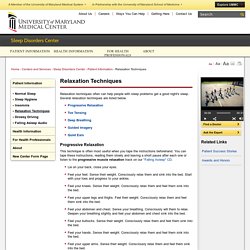
Several relaxation techniques are listed below. Progressive Relaxation This technique is often most useful when you tape the instructions beforehand. You can tape these instructions, reading them slowly and leaving a short pause after each one or listen to the progressive muscle relaxation track on our "Falling Asleep" CD. Lie on your back, close your eyes. Top Toe Tensing This one may seem like a bit of a contradiction to the previous one, but by alternately tensing and relaxing your toes, you actually draw tension from the rest of the body.
Lie on your back, close your eyes. Deep Breathing Listen to the deep breathing track on our "Falling Asleep" CD. By concentrating on our breathing, deep breathing allows the rest of our body to relax itself. All About Depression: Online Relaxation Exercises. On this page you will find a variety of relaxation exercises as QuickTime files that you can play on your computer.
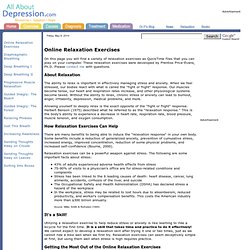
These relaxation exercises were developed by Prentiss Price-Evans, Ph.D. Please contact me with questions. The Mindful Way Through Anxiety » Exercises. Cultivating Emotional Mindfulness: What, Why, and How. The ability to mindfully experience, regulate, and respond to one’s feelings is essential to mental health and well-being.
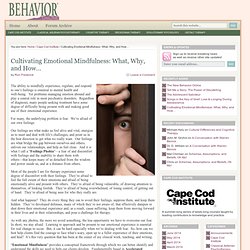
Yet problems managing emotion abound and play a central role in most psychiatric disorders. Regardless of diagnosis, many people seeking treatment have some degree of difficulty being present with and making good use of their emotional experience. For many, the underlying problem is fear. We’re afraid of our own feelings. Our feelings are what make us feel alive and vital, energize us to meet and deal with life’s challenges, and point us in the best direction to get what we really want.
Most of the people I see for therapy experience some degree of discomfort with their feelings. And what happens? As with any phobia, the more we avoid something, the less opportunity we have to overcome our fear. “Emotional Mindfulness” provides a conceptual framework through which we can better identify and understand the skills we need to help our clients develop.
Books and Other Resources Recommended by the UCSD Center for Mindfulness - Recommended Reading. Center for Mindfulness at UC San Diego Health System. The UCSD Center for Mindfulness is a multi-faceted program of clinical care, professional training, education, research and outreach intended to further the practice and integration of mindfulness into all aspects of society.
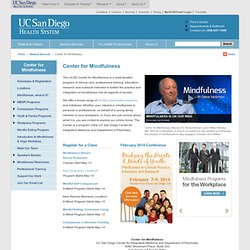
We offer a broad range of mindfulness-based programs and initiatives. Whether your interest in mindfulness is personal or professional, on behalf of a young family member or your workplace, or if you are just curious about what it is, you are invited to explore our online home. The Center is a program of the UC San Diego Center for Integrative Medicine and Department of Psychiatry.
Center for Mindfulness Director, Dr. Steve Hickman, joins William Mobley, MD, PhD for a discussion of how to be present in the moment and leverage the practice of mindfulness to stay engaged, focused, and fulfilled.
What is Mindfulness? What is mindfulness?
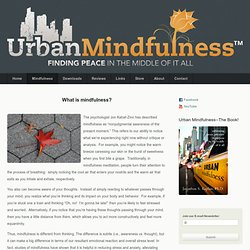
The psychologist Jon Kabat-Zinn has described mindfulness as “nonjudgmental awareness of the present moment.” This refers to our ability to notice what we’re experiencing right now without critique or analysis. For example, you might notice the warm breeze caressing our skin or the burst of sweetness when you first bite a grape. Traditionally, in mindfulness meditation, people turn their attention to the process of breathing: simply noticing the cool air that enters your nostrils and the warm air that exits as you inhale and exhale, respectively.
Quick Relaxation Techniques. Mindfulness in Everyday Life. Mindfulness of Emotions. Mindful Eating. Mindfulness of Things. The Institute for Meditation and Psychotherapy. Be Mindful. Moodscope - Lift your mood with a little help from your friends. Wellness Education. Wellness Education A department of Wellness USF Exercise is Medicine Wellness Education www.usf.edu/wellness wellness@usf.edu Active Living and Healthy Eating Alcohol and Other Drugs Colds, Flu, and Other Stuff Healthy Relationships Life Balance Living Learning Community About Wellness Living Learning Community Mental Health Presentations Safety Sexual Health Sleep Concerns.

Guided Meditation & Mindfulness App. MindBody Lab. Counseling and Mental Health Center SSB 5th Floor Hours: Monday- Friday, 8:00 a.m. - 4:00 p.m.
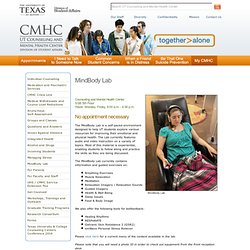
No appointment necessary The MindBody Lab is a self-paced environment designed to help UT students explore various resources for improving their emotional and physical health. The Lab currently features audio and video instruction on a variety of topics. Most of this material is experiential, enabling students to follow along and practice the skills as they are being discussed. The MindBody Lab currently contains information and guided exercises on: Breathing ExercisesMuscle RelaxationMeditationRelaxation Imagery / Relaxation SoundsGuided ImageryHealth & Well BeingSleep IssuesFood & Body Image We also offer the following tools for biofeedback: Healing Rhythms RESPeRATE Galvanic Skin Resistance 2 (GSR2) emWave Personal Stress Reliever Please click here for a current menu of the content available in the lab. Below is a sample of some of the content that you will find in the MindBody Lab.